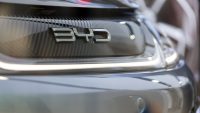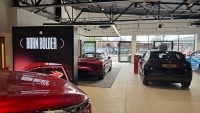 Giugiaro-designed family hatchbacks have long been the stuff of legend. Ever since the master created the original Volkswagen Golf, car firms have clamored for his services. In his time, he’s done the Lancia Delta, Fiat Panda, Fiat Uno, Fiat Grande Punto, Saab 9000, Daewoo Lacetti…
Giugiaro-designed family hatchbacks have long been the stuff of legend. Ever since the master created the original Volkswagen Golf, car firms have clamored for his services. In his time, he’s done the Lancia Delta, Fiat Panda, Fiat Uno, Fiat Grande Punto, Saab 9000, Daewoo Lacetti…
Okay then, it’s not quite a 100 per cent hit rate, but the Giugiaro connection still brings with it a certain kudos. No doubt it’s this that encouraged Renault to sign him up and replace its languid 9 and 11 family car range in 1988. Unfortunately, the emergent 19 was more of a Lacetti than a Lancia. What was that about hit rate?
Sure, it was an understated, forgettable car. Fellow designers of the time, if they could be bothered, moaned that it was hardly Renault pushing the boundaries, in the way the old 5 and 16 did. That’s more a reflection on car design at the time, though. In its own way, the 19 helped pave the way for progressively more flash Renault designs.
And surprisingly, it has a firm place in Renault history books through merit. Bet you didn’t know the 19 was the last Renault model to be known by number, not name? It is so; a few years later, the Clio did for the 5, Laguna saw to the 21: the 19 itself put a tentative toe into this naming water, by calling the saloon version ‘Chamade’.
Mind you, the water can’t have been good at first. The Chamade tag was quietly dropped a few years later…
It was thus bizarre of Renault to later big up the number in its ad campaigns. But that’s just what they did with the 19 16v model: who remembers the ’19 into 16 DOES go’ press advertisements? Maybe this was the traditionalist marketing types mourning the failed number game with a bang.
That 16v version was, incidentally, another understatedly significant car. Renault is known for the mighty Renaultsport brand nowadays, but back then, hot hatches outside the supermini mould were non-existent. As the 19 16v was fast, great-looking AND drove sublimely, see it as marketing’s green light to do more of them in the coming years.
Karmann nicked the 16v engine (and its complementary bonnet scoop) for a very pretty convertible version a little while later. Again, another example of Renault expanding what it could do with a platform – and while it was, how shall we say, ‘a bit’ flexible, the success of the convertible conversion seemed to get them thinking…
See, after being facelifted (and almost entirely eliminating the original’s already-negligible character) in 1992, the 19 was eventually replaced in 1996, by the Megane.
Name for number, you see – and at the time, Renault boasted that it wasn’t just one car that would replace it, but many cars. Megane hatch, yes: but also, Megane coupe, saloon, estate, convertible, even a newfangled people carrier variant, the Scenic.
All thinking that was rooted in the 19: the Megane was basically a Phase 2 19 with a new body on top.
That means while the 19 sold 150,000 units here in the UK through its lifetime, it’s actually sold many more than that because its underpinning could still be found in Renault car dealers right up until 2002.
So, no, it’s hardly a classic, and will probably be forgotten the moment you turn the page. But sales legend? Well, be kind, and you could say it’s one of the most noteworthy French cars of recent times.
































